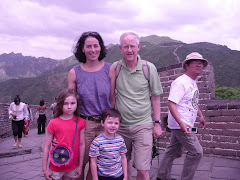
Last month, when Lucinda and Arno didn't have school, I took them to see one of the three annual Grand Sumo tournaments in Tokyo. It was fantastic. The kids loved it and it was, astonishingly, one of the best bargain outings this city has to offer.
I learned a lot about sumo when I wrote a story about it for Kateigaho International Edition, the arts and culture magazine that I work for in Tokyo. Last October, I went to a sumo "stable" to see an incredibly grueling practice session, interviewed a wrestler named Chiyoshuhou, and ate lunch with a group of the lower-ranked men. Here is my post about my visit to the Kokonoe-beya stable.
Of the six national tournaments every year, three are held in Tokyo. Each tournament lasts for 15 days; in the top two divisions (Makuuchi and Juryo), the wrestlers have 1 match each day. The lower divisions compete in 7 matches each. Those who win a majority of their matches improve their ranking; those who lose a majority slip lower in the rankings. (Here's the tournament website for details.)
The Grand Sumo tournaments take place near the Ryogoku subway station in the Kokugikan arena. There are sumo murals painted outside.

This is what it looks like inside. Google tells me that sumo is deeply tied to the shinto religion and shinto ritual. The wrestlers face off on a clay-and-rice-straw platform that is rebuilt for every tournament, consecrated by priests and off-limits to women.


If you buy general admission tix, you can sit right in front until it gets more crowded. So we had great views all day. I even saw the wrestler whom I interviewed - and he won his match.

Going to sumo is kind of like going to the circus. People order box lunches, beer and sake that are delivered to their seats in large shopping bags. Our lunch was this huge box of Morinaga's Milk Caramels.

At noon, we wandered around and watched lower-ranked wrestlers walk around in colorful cotton yukata and sandals. Highly ranked wrestlers wear more expensive dark-colored kimonos and seem always to be followed around by younger rikishi carrying supplies in plastic boxes. Wrestlers have greased topknots, and the Old-Spice-like smell of the grease pervades the arena.

There are, naturally, all sorts of sumo trinkets to buy - and we bought Blaine the coffee mug on the right.



The main events -- matches in sumo's top two divisions -- begin at 2:30pm. In box seats, before their ticketholders arrived, we watched a procession of the Juryo (second-highest) division. These guys are not necessarily that tall, but they are quite huge - probably 250+ lbs. They get to wear one of the "skirts," which typically cost thousands of dollars (or millions of yen) and are sometimes covered in jewels, when they reach the top two divisions.
Here's one of the matches, captured on my little digital camera. One of the wrestlers might be Bulgarian - definitely not Japanese. Audio from Lucinda: "Why is he choking him? Why is that other guy choking him?"
We left at 3:30pm - 5 hours after we arrived - just as the matches in the top division were about to begin. I'll definitely take the children back and hopefully Blaine can come along, too.

No comments:
Post a Comment